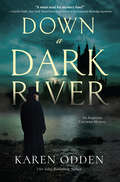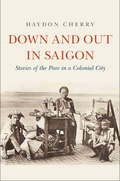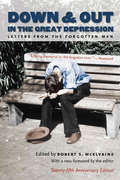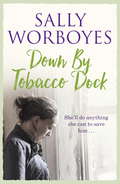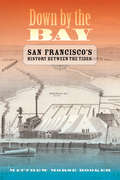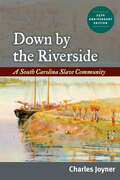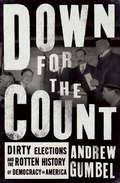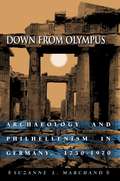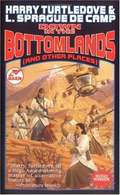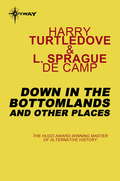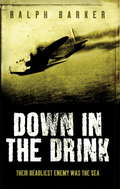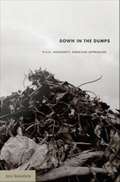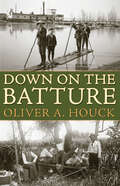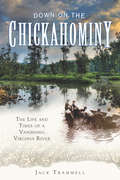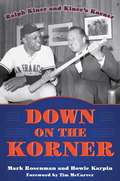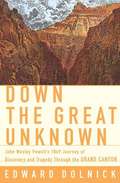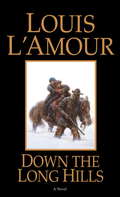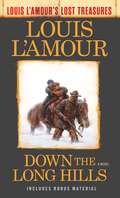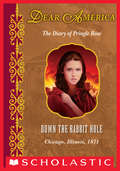- Table View
- List View
Down Weavers Lane: The Staley Family, Book 1
by Anna Jacobs'Best period book I have EVER read! - 5-star reader review'Anna Jacob's riveting new Lancashire saga introduces an unforgettable heroine.Emmy Carter's mother is a prostitute - and her life has made Emmy determined to avoid the same fate. But Emmy is beautiful, so attracts unwanted attention; her mother's protector has his eye on her, as does evil Marcus Armistead, her employer's nephew. Marcus is excited by Emmy's virginity and has her kidnapped, but Emmy hits him over the head and escapes. Marcus, futher enraged, kills her mother and becomes even more determined to rape Emmy, but the combined efforts of the local parson and Emmy's young suitor manage to keep her safe from harm. Finally Emmy sees Marcus get his just desserts, finds out who her father was, and attains the respectability she has so longed for.***********************What readers are saying about DOWN WEAVER'S LANE'Could not put this book down' - 5 stars'Kept wanting to read it all in one go' - 5 stars'Such a brilliant writer . . . once you start to read this book you won't be able to put it down' - 5 stars'A gripping novel' - 5 stars'This book was brilliant - get the tissues ready!' - 5 stars(P)2009 Isis Publishing Ltd
Down a Dark River (An Inspector Corravan Mystery)
by Karen OddenIn the vein of C. S. Harris and Anne Perry, Karen Odden&’s mystery introduces Inspector Michael Corravan as he investigates a string of vicious murders that has rocked Victorian London&’s upper crust.London, 1878. One April morning, a small boat bearing a young woman&’s corpse floats down the murky waters of the Thames. When the victim is identified as Rose Albert, daughter of a prominent judge, the Scotland Yard director gives the case to Michael Corravan, one of the only Senior Inspectors remaining after a corruption scandal the previous autumn left the division in ruins. Reluctantly, Corravan abandons his ongoing case, a search for the missing wife of a shipping magnate, handing it over to his young colleague, Mr. Stiles. An Irish former bare-knuckles boxer and dockworker from London&’s seedy East End, Corravan has good street sense and an inspector&’s knack for digging up clues. But he&’s confounded when, a week later, a second woman is found dead in a rowboat, and then a third. The dead women seem to have no connection whatsoever. Meanwhile, Mr. Stiles makes an alarming discovery: the shipping magnate&’s missing wife, Mrs. Beckford, may not have fled her house because she was insane, as her husband claims, and Mr. Beckford may not be the successful man of business that he appears to be. Slowly, it becomes clear that the river murders and the case of Mrs. Beckford may be linked through some terrible act of injustice in the past—for which someone has vowed a brutal vengeance. Now, with the newspapers once again trumpeting the Yard&’s failures, Corravan must dredge up the truth—before London devolves into a state of panic and before the killer claims another innocent victim.
Down and Out in Saigon: Stories of the Poor in a Colonial City
by Haydon CherryA moving portrait of the lives of six poor city-dwellers, set in early twentieth century colonial Saigon Historian Haydon Cherry offers the first comprehensive social history of the urban poor of colonial French Saigon by following the lives of six individuals—a prostitute, a Chinese laborer, a rickshaw puller, an orphan, an incurable invalid, and a destitute Frenchman—and how they navigated the ups and downs of the regional rice trade and the institutions of French colonial rule in the first half of the twentieth century. “Down and Out in Saigon is marked by three qualities that endow it with unusual value: the originality of its subject matter, as the first and only history of colonial Saigon’s poor population, the excellence of its research, and Cherry’s elegant prose.”—Peter B. Zinoman, University of California, Berkeley “This is more than a corrective of revolutionary historiography—it is a tour de force that brings marginal and forgotten lives into the story of modern Vietnamese history.”—Charles Keith, author of Catholic Vietnam: A Church from Empire to Nation
Down and Out in the Great Depression: Letters from the Forgotten Man
by Robert S. Mcelvaine"Down and Out in the Great Depression" is a moving, revealing collection of letters by the forgotten men, women, and children who suffered through one of the greatest periods of hardship in American history. Sifting through some 15,000 letters from government and private sources, Robert McElvaine has culled nearly 200 communications that best show the problems, thoughts, and emotions of ordinary people during this time. Unlike views of Depression life "from the bottom up" that rely on recollections recorded several decades later, this book captures the daily anguish of people during the thirties. It puts the reader in direct contact with Depression victims, evoking a feeling of what it was like to live through this disaster. Following Franklin D. Roosevelt's inauguration, both the number of letters received by the White House and the percentage of them coming from the poor were unprecedented. The average number of daily communications jumped to between 5,000 and 8,000, a trend that continued throughout the Roosevelt administration. The White House staff for answering such letters--most of which were directed to FDR, Eleanor Roosevelt, or Harry Hopkins--quickly grew from one person to fifty. Mainly because of his radio talks, many felt they knew the president personally and could confide in him. They viewed the Roosevelts as parent figures, offering solace, help, and protection. Roosevelt himself valued the letters, perceiving them as a way to gauge public sentiment. The writers came from a number of different groups--middle-class people, blacks, rural residents, the elderly, and children. Their letters display emotional reactions to the Depression--despair, cynicism, and anger--and attitudes toward relief. In his extensive introduction, McElvaine sets the stage for the letters, discussing their significance and some of the themes that emerge from them. By preserving their original spelling, syntax, grammar, and capitalization, he conveys their full flavor. The Depression was far more than an economic collapse. It was the major personal event in the lives of tens of millions of Americans. McElvaine shows that, contrary to popular belief, many sufferers were not passive victims of history. Rather, he says, they were "also actors and, to an extent, playwrights, producers, and directors as well," taking an active role in trying to deal with their plight and solve their problems.
Down and Out in the New Economy: How People Find (or Don’t Find) Work Today
by Ilana GershonFinding a job used to be simple. You’d show up at an office and ask for an application. A friend would mention a job in their department. Or you’d see an ad in a newspaper and send in your cover letter. Maybe you’d call the company a week later to check in, but the basic approach was easy. And once you got a job, you would stay—often for decades. Now . . . well, it’s complicated. If you want to have a shot at a good job, you need to have a robust profile on LinkdIn. And an enticing personal brand. Or something like that—contemporary how-to books tend to offer contradictory advice. But they agree on one thing: in today’s economy, you can’t just be an employee looking to get hired—you have to market yourself as a business, one that can help another business achieve its goals. That’s a radical transformation in how we think about work and employment, says Ilana Gershon. And with Down and Out in the New Economy, she digs deep into that change and what it means, not just for job seekers, but for businesses and our very culture. In telling her story, Gershon covers all parts of the employment spectrum: she interviews hiring managers about how they assess candidates; attends personal branding seminars; talks with managers at companies around the United States to suss out regional differences—like how Silicon Valley firms look askance at the lengthier employment tenures of applicants from the Midwest. And she finds that not everything has changed: though the technological trappings may be glitzier, in a lot of cases, who you know remains more important than what you know. Throughout, Gershon keeps her eye on bigger questions, interested not in what lessons job-seekers can take—though there are plenty of those here—but on what it means to consider yourself a business. What does that blurring of personal and vocational lives do to our sense of our selves, the economy, our communities? Though it’s often dressed up in the language of liberation, is this approach actually disempowering workers at the expense of corporations? Rich in the voices of people deeply involved with all parts of the employment process, Down and Out in the New Economy offers a snapshot of the quest for work today—and a pointed analysis of its larger meaning.
Down by Tobacco Dock: A historical East End saga full of secrets and intrigue
by Sally Worboyes'She brings the East End to life' Barbara WindsorIn 1876, the homes of the poor working class in the East End are being replaced by splendid houses for the rich. When Kelly's Yard comes under threat, Maria Bertram inspires her neighbours to rebel against eviction. But when a woman is found murdered in Tobacco Dock and the young man Maria loves is arrested, she must do everything in her power to prove his innocence and save him from a public hanging. Without realising it, she puts her own life at risk when she stumbles across a web of deceit in the planner's office. It seems the murderer is much closer to home than she thinks...A historical East End saga full of secrets and intrigue that will enthral fans of Dilly Court, Rosie Goodwin and Catherine Cookson.
Down by Tobacco Dock: A historical East End saga full of secrets and intrigue
by Sally Worboyes'She brings the East End to life' Barbara WindsorIn 1876, the homes of the poor working class in the East End are being replaced by splendid houses for the rich. When Kelly's Yard comes under threat, Maria Bertram inspires her neighbours to rebel against eviction. But when a woman is found murdered in Tobacco Dock and the young man Maria loves is arrested, she must do everything in her power to prove his innocence and save him from a public hanging. Without realising it, she puts her own life at risk when she stumbles across a web of deceit in the planner's office. It seems the murderer is much closer to home than she thinks...A historical East End saga full of secrets and intrigue that will enthral fans of Dilly Court, Rosie Goodwin and Catherine Cookson.
Down by the Bay: San Francisco's History between the Tides
by Matthew Morse BookerSan Francisco Bay is the largest and most productive estuary on the Pacific Coast of North America. It is also home to the oldest and densest urban settlements in the American West. Focusing on human inhabitation of the Bay since Ohlone times, Down By The Bay reveals the ongoing role of nature in shaping that history. From birds to oyster pirates, from gold miners to farmers, from salt ponds to ports, this is the first history of the San Francisco Bay and Delta as both a human and natural landscape. It offers invaluable context for current discussions over the best management and use of the Bay in the face of sea level rise.
Down by the Riverside: A South Carolina Slave Community (Blacks in the New World)
by Charles JoynerIn Down by the Riverside, Charles Joyner takes readers on a journey back in time, up the Waccamaw River through the Lowcountry of South Carolina, past abandoned rice fields once made productive by the labor of enslaved Africans, past rice mills and forest clearings into the antebellum world of All Saints Parish. In this slave community, and many others like it, the slaves created a new language, a new religion--indeed, a new culture--from African traditions and American circumstances. From the letters, diaries, and memoirs of the plantation whites and their guests, from quantitative analysis of census and probate records, and above all from slave folklore and oral history, Joyner has recovered an entire society and its way of life. His careful reconstruction of daily life in All Saints Parish is an inspiring testimony to the ingenuity and solidarity of a people who endured in the face of adversity. This anniversary edition of Joyner's landmark study includes a new introduction in which the author recounts his process of writing the book, reflects on its critical and popular reception, and surveys the path of scholarship in slave history in the decades since the book's first publication.
Down for the Count: Dirty Elections and the Rotten History of Democracy in America
by Andrew GumbelThe updated edition of Steal This Vote—a rollicking history of US voter suppression and fraud from Jacksonian democracy to Citizens United and beyond. In Down for the Count, award-winning journalist Andrew Gumbel explores the tawdry history of elections in the United States. From Jim Crow to Tammany Hall to the Bush v. Gore Florida recount, it is a chronicle of votes bought, stolen, suppressed, lost, miscounted, thrown into rivers, and litigated up to the Supreme Court. Gumbel then uses this history to explain why America is now experiencing the biggest backslide in voting rights in more than a century. First published in 2005 as Steal This Vote, this thoroughly revised and updated edition reveals why America faces so much trouble running clean, transparent elections. And it demonstrates how the partisan battles now raging over voter IDs, campaign spending, and minority voting rights fit into a long, largely unspoken tradition of hostility to the very notion of representative democracy. Interviewing Democrats, Republicans, and a range of voting rights activists, Gumbel offers an engaging and accessible analysis of how our democratic integrity is so often corrupted by racism, money, and power. In an age of high-stakes electoral combat, billionaire-backed candidacies, and bottom-of-the-barrel campaigning, this book is more important than ever. &“In a riveting and frightening account, Gumbel . . . traces election fraud in America from the 18th century to the present . . . [the issues he] so winningly addresses are crucial to the future of democracy.&” —Publishers Weekly, on Steal This Vote
Down from Olympus: Archaeology and Philhellenism in Germany, 1750-1970
by Suzanne L. MarchandSince the publication of Eliza May Butler's Tyranny of Greece over Germany in 1935, the obsession of the German educated elite with the ancient Greeks has become an accepted, if severely underanalyzed, cliché. In Down from Olympus, Suzanne Marchand attempts to come to grips with German Graecophilia, not as a private passion but as an institutionally generated and preserved cultural trope. The book argues that nineteenth-century philhellenes inherited both an elitist, normative aesthetics and an ascetic, scholarly ethos from their Romantic predecessors; German "neohumanists" promised to reconcile these intellectual commitments, and by so doing, to revitalize education and the arts. Focusing on the history of classical archaeology, Marchand shows how the injunction to imitate Greek art was made the basis for new, state-funded cultural institutions. Tracing interactions between scholars and policymakers that made possible grand-scale cultural feats like the acquisition of the Pergamum Altar, she underscores both the gains in specialized knowledge and the failures in social responsibility that were the distinctive products of German neohumanism.This book discusses intellectual and institutional aspects of archaeology and philhellenism, giving extensive treatment to the history of prehistorical archaeology and German "orientalism." Marchand traces the history of the study, excavation, and exhibition of Greek art as a means to confront the social, cultural, and political consequences of the specialization of scholarship in the last two centuries.
Down in My Heart, Second Edition
by William Stafford(From the back cover) "Down in My Heart has an autobiographical dimension, a shy but brave sense of quest, of inner evolution, of maturation and growth from eager idealism at the beginning to ironic wariness verging on disillusionment at the close, that was so telling a measure for all of us who shared the CO experience. But. Stafford registers a feeling of absolute integrity within a situation of social alienation that is extraordinary, the more so because it is unconscious, emerging as the subsumed virtue of the work. In the quiet immediacy of his prose the future poet is alive and breathing. All in all, a perceptive glimpse into a most painful interval of our national life." --William Everson From 1940 to 1944, William Stafford was interned in the camps for conscientious objectors in the United States. As a pacifist, he worked for the Civilian Public Service on forest and soil conservation projects in Arkansas, California, and Illinois. As a writer, he recorded the life he found there; the fellowship within the camps and the antagonism outside them. Down in My Heart is an account of the relationships among the people in the camps, their day-to-day activities: fighting forest fires, building roads, terracing eroded lands, and their earnest pursuit of a social morality rooted in religious and secular pacifist ideals. Since then, William Stafford has published several collections of poetry, and he has published his views on the writer's vocation. He has been the Poetry Consultant for the Library of Congress, and received the highest praise as a poet and an educator. His awards include the National Book Award, the Shelley Memorial Award, and the American Academy and Institute of Arts and Letters Award in Literature.
Down in the Bottomlands (And Other Places)
by Harry Turtledove L. Sprague de CampIn Down in the bottomlands, Turtledove explores a world where there's an almost uninhabitable bottomland that tourists lke to explore. But what would happen if terrorists planned to fill the historically dray bottmlands with water by knocking down the mountains around the bottomlands with a bomb? In The Wheels of If, a man is launched onto his "Wheel of If", and into a conditional world where Indians (Screllings) rule and the white man JUST coexist. In The Pugnacious Peacemaker, we're aken again into the world set out in The Wheel of If. This is a great story that'll teach you a thing or two not only about the history of today but also about the history of lands that don't really exist.
Down in the Bottomlands: And Other Places
by Harry Turtledove L. Sprague deCampIn the real world, the Mediterranean basin dried up several times, only to refill again. If it hadn't, what's really sea bottom would have become the most savage desert in the world. Mild-mannered Radnal vez Krobir likes it that way. When his kingdom's enemies try to shake down the Barrier Mountains and let the Atlantic in, he has to stop them - or else drown along with everything he holds dear.
Down in the Drink: Their Deadliest Enemy Was the Sea
by Ralph BarkerTo crash or be shot down into the sea is a terrifying experience. And to escape to tell the tale is a rare and remarkable achievement. But that is precisely what each of the World War Two heroes described here has done; they have come 'down in the drink' and miraculously survived. In doing so, they have all qualified for the 'Goldfish Club'. Ralph Barker tells the hair-raising and inspiring stories of eight such air crews. There is the tale of the Beaufort that ditches in the North Sea, the Wellington crew stranded in the Bay of Biscay and the Mosquito fighter-bomber trapped in the sea off Burma, keeping afloaton the wreckage of his fuselage,concussed, his bones broken, withonly a flask of whisky to keep him going. In DOWN IN THE DRINK, the accounts of heroism and endurance match any from that historic time. They are stories of men from all corners of the British Commonwealth fighting for survival against unimaginable odds. No one could read of their experiences without being stirred by the proof they give that there is no limit to human courage.
Down in the Dumps: Place, Modernity, American Depression
by Jani ScanduraMucking around in the messy terrain of American trash, Jani Scandura tells the story of the United States during the Great Depression through evocative and photo-rich portraits of four locales: Reno, Key West, Harlem, and Hollywood. In investigating these Depression-era "dumps," places that she claims contained and reclaimed the cultural, ideological, and material refuse of modern America, Scandura introduces the concept of "depressive modernity," an enduring affective component of American culture that exposes itself at those moments when the foundational myths of America and progressive modernity--capitalism, democracy, individualism, secularism, utopian aspiration--are thrown into question. Depressive modernity is modernity at a standstill. Such a modernity is not stagnant or fixed, nor immobile, but is constituted by an instantaneous unstaging of desire, territory, language, and memory that reveals itself in the shimmering of place. An interpretive bricolage that draws on an unlikely archive of 1930s detritus--office memos, scribbled manuscripts, scrapbooks, ruined photographs, newspaper clippings, glass eyes, incinerated stage sets, pulp novels, and junk washed ashore--Down in the Dumps escorts its readers through Reno's divorce factory of the 1930s, where couples from across the United States came to quickly dissolve matrimonial bonds; Key West's multilingual salvage economy and its status as the island that became the center of an ideological tug-of-war between the American New Deal government and a politically fraught Caribbean; post-Renaissance Harlem, in the process of memorializing, remembering, grieving, and rewriting a modernity that had already passed; and Studio-era Hollywood, Nathanael West's "dump of dreams," in which the introduction of sound in film and shifts in art direction began to transform how Americans understood place-making and even being itself. A coda on Alcatraz and the Pentagon brings the book into the present, exploring how American Depression comes to bear on post-9/11 America.
Down on the Batture
by Oliver A. HouckThe lower Mississippi River winds past the city of New Orleans between enormous levees and a rim of sand, mud, and trees called “the batture.” On this remote and ignored piece of land thrives a humanity unique to the region—ramblers, artists, drinkers, fishers, rabbit hunters, dog walkers, sunset watchers, and refugees from immigration, alimony, and other aspects of modern life. Author Oliver A. Houck has frequented this place for the past twenty-five years. Down on the Batture describes a life, pastoral, at times marginal, but remarkably fecund and surprising. From this place he meditates on Louisiana, the state of the waterway, and its larger environs. He describes all the actors who have played lead roles on the edge of the mightiest river of the continent, and includes in his narrative plantations, pollution, murder, land grabs, keelboat brawlers, slave rebellions, the Corps of Engineers, and the oil industry. Houck draws from his experience in New Orleans since the early 1970s in the practice and teaching of law. He has been a player in many of the issues he describes, although he does not undertake to argue them here. Instead, story by story, he uses the batture to explore the forces that have shaped and spell out the future of the region. The picture emerges of a place that—for all its tangle of undergrowth, drifting humanity, shifting dimensions in the rise and fall of floodwater—provides respite and sanctuary for values that are original to America and ever at risk from the homogenizing forces of civilization.
Down on the Chickahominy: The Life and Times of a Vanishing Virginia River
by Jack TrammellFor centuries, the "Chick" has blessed the Tidewater region of Virginia with life, even today in the face of deteriorating resources and dramatic environmental change. While an abundant ecosystem thrived in the water, a unique and culturally rich community that once dotted the Chick's riverbanks has dwindled near extinction. Author Jack Trammell spent the past three years on the river researching its incredible past and uncertain future. Drawing on old letters, photographs, and the still extant memories of lifelong watermen like Captains Bill Buck Jr. and Art Conway, he weaves a fascinating narrativeof this river community. Hop onboard and join the search for the record perch, the vanished villages, the proud Chickahominy Tribe, and the vestiges of the Civil War in this definitive and easy-to navigate history of a sacred Virginia tributary.
Down on the Korner: Ralph Kiner and Kiner's Korner
by Mark Rosenman Howie Karpin Tim McCarverOne of the staples of the long and storied history of baseball on television is the "postgame show,” and none was more beloved than Kiner’s Korner. From the early 1960s into the 1990s, Hall of Famer and iconic broadcaster Ralph Kiner hosted the show that brought players into the homes of fans across the nation.From the host, to the set, to the guests, to the stories amassed over more than thirty-two years on the air, Down on the Korner takes the reader behind the scenes. Authors Mark Rosenman and Howie Karpin gather insight from baseball greats like Ed Charles, Ron Darling, Pete Falcone, "Doc” Gooden, Keith Hernandez, Tim Harkness, Ron Hunt, Howard Johnson, Darryl Strawberry, Bobby Valentine, and many more. People who worked behind the scenes provide memorable moments of their own-like the time producer Jack Simon joined Jerry Koosman to play a practical joke on Hall of Famer and legendary Met Tom Seaver.Throughout his career as a player and broadcaster, Ralph Kiner was adored by millions of fans. His postgame show only strengthened that bond. Down on the Korner will give readers a wonderful ride down sports’ memory lane-an enjoyable journey for any baseball enthusiast.Skyhorse Publishing, as well as our Sports Publishing imprint, are proud to publish a broad range of books for readers interested in sports-books about baseball, pro football, college football, pro and college basketball, hockey, or soccer, we have a book about your sport or your team.Whether you are a New York Yankees fan or hail from Red Sox nation; whether you are a die-hard Green Bay Packers or Dallas Cowboys fan; whether you root for the Kentucky Wildcats, Louisville Cardinals, UCLA Bruins, or Kansas Jayhawks; whether you route for the Boston Bruins, Toronto Maple Leafs, Montreal Canadiens, or Los Angeles Kings; we have a book for you. While not every title we publish becomes a New York Times bestseller or a national bestseller, we are committed to publishing books on subjects that are sometimes overlooked by other publishers and to authors whose work might not otherwise find a home.
Down the Figure 7
by Trevor HoyleThe war's over, but kids are still fighting the enemy - until a soldier returns home and suddenly there's real-life danger, and real tragedy.On the wasteland between their houses, Terry Webb and his mates are battling the Nazzies and Nips, inflamed by the Movietone News at the Saturday matinee, the exploits of Hollywood tough guys and the tales of brothers and dads and uncles who fought for their country. But in the 1950s, Britain is struggling to emerge from beneath the long shadow left in the wake of the Second World War. Life is all rationing, 'make-do-and-mend', deprivation and poverty, especially in the Northern cotton towns.As far as the boys are concerned it's all just a bit of fun, just like their opportunistic fumblings and increasing interest in girls - until Terry's favourite uncle, a Desert Rat, comes home, bearing all the scars of Monty's North Africa campaign and bringing a piece of the war back with him. And suddenly for Terry, life's no longer a game, but there's real-life danger - and real-life tragedy . . .The past is truly is a foreign country in this coming-of-age novel based on Trevor Hoyle's short story, the winner of the Transatlantic Review short story competition, evoking the joys, frustrations, injustices, excitement, battles, discoveries and bloody-minded wonder of a boy slowly learning to become a man.
Down the Great Unknown: John Wesley Powell's 1869 Journey of Discovery and Tragedy through the Grand Canyon
by Edward Dolnick0n May 24, 1869, a one-armed Civil War veteran named John Wesley Powell and a ragtag band of nine mountain men embarked on the last great quest in the American West. No one had ever explored the fabled Grand Canyon; to adventurers of that era it was a region almost as mysterious as Atlantis -- and as perilous. The ten men set out down the mighty Colorado River in wooden rowboats. Six survived. Drawing on rarely examined diaries and journals, Down the Great Unknown is the first book to tell the full, true story.
Down the Hill: My Descent into the Double Murder in Delphi
by Susan HendricksFormer CNN/HLN anchor and veteran broadcast journalist Susan Hendricks takes an investigative deep-dive into the still-unsolved double homicide of two teens in Delphi, Indiana—and its lasting impact on the community On February 13, 2017, two teenage girls—13-year-old Abby Williams and 14-year-old Libby German—decided to enjoy a day off from school by exploring the popular hiking trails near the Monon High Bridge just a few minutes&’ drive from Libby&’s home in Delphi, Indiana. Libby&’s sister, Kelsi, dropped the two girls off at the head of the trail and waved to them as they walked down the path, which was the last time they&’d ever be seen alive. Less than 24 hours later, their bodies were found on the north bank of Deer Creek, about a mile from where they were last seen. There were few clues and little to go on in terms of physical evidence, except for the visual and audio remnants of a strange encounter the girls had with a stranger just hours before their disappearance, an encounter unsettling enough that Libby had thought to record it on her cellphone as it unfolded. In the years since the murders were first made public, Libby&’s audio and video recordings have been released and two very different composite sketches of the suspect have been shown, but local law enforcement remained vague about developments for years—until finally, in October 2022, the long-awaited suspect was arrested and a trial date was set. Longtime anchor and journalist Susan Hendricks was one of the first reporters to cover the case. A broadcast veteran with decades&’ worth of experience under her belt, she was no stranger when it came to sharing the tragedies of the day with viewers. But there was something about this case that rattled her to her core. A year after the murders, Susan went to Delphi to interview the victims&’ families for an in-depth special report where Kelsi drove Susan down the same path that she drove her sister down on the last day of her life. Over the years, Susan has built close relationships with family members, and law enforcement officials and armchair detectives alike who are determined to get justice for Abby and Libby. In Down the Hill, Hendricks digs deeper in into the mystery that has captivated our nation for years, exploring the family's enduring resilience and advocacy, as well as the rippling impact the case has had on not just Delphi, but the very heart of the American heartland. As a result, this book is more than just a book about a double homicide; it&’s about a small town in middle America that&’s been haunted by an unfathomable act of violence; it&’s about the ways families and communities cope with grief and move forward after tragedy; it&’s about the limitations of local law enforcement and the rise of technology in helping to solve cases in new ways. But it&’s also about compassion, connection, empathy, and resilience—on a very real, very human level.
Down the Long Hills
by Louis L'AmourAfter the massacre, Hardy and Betty Sue were left with only a horse and a knife with which to face the long battle against the wilderness. Stranded on the limitless prairie, the children were up against starvation, Indians, and wild animals. They were both mighty stubborn--but the odds were against them. Reissue.
Down the Long Hills (Louis L'Amour's Lost Treasures): A Novel
by Louis L'AmourAs part of the Louis L’Amour’s Lost Treasures series, this edition contains exclusive bonus materials!Everyone was dead. Indian raiders massacred the entire wagon train. Only seven-year-old Hardy Collins and three-year-old Betty Sue Powell managed to survive. With a knife, a horse, and the survival lessons his father taught him, Hardy must face the challenges of the open prairie. Using ingenuity and common sense, he builds shelters, searches out water, and forages for food. But as he struggles to keep them alive, he realizes that their survival will depend on his ability to go beyond what his father was able to teach him. Hardy bravely presses on, fighting off the temptation to give up, until a howling blizzard and a pack of hungry wolves force him to make decisions that no seven-year-old boy should ever have to make.Louis L’Amour’s Lost Treasures is a project created to release some of the author’s more unconventional manuscripts from the family archives. In Louis L’Amour’s Lost Treasures: Volumes 1, Beau L’Amour takes the reader on a guided tour through many of the finished and unfinished short stories, novels, and treatments that his father was never able to publish during his lifetime. L’Amour’s never-before-seen first novel, No Traveller Returns, will also be released as a Lost Treasures publication, followed by Louis L’Amour’s Lost Treasures: Volume 2. Additionally, many beloved classics will be rereleased with an exclusive Lost Treasures postscript featuring previously unpublished material, including outlines, plot notes, and alternate drafts. These postscripts tell the story behind the stories that millions of readers have come to know and cherish.
Down the Rabbit Hole: The Diary Of Pringle Rose (Dear America)
by Susan Campbell BartolettiNewbery Honor author Susan Campbell Bartoletti brings the story of a young girl caught up in a web of murder, lies, and the Great Fire of Chicago to bold life.In the spring of 1871, fourteen-year-old Pringle Rose learns that her parents have been killed in a terrible carriage accident. After her uncle Edward and his awful wife, Adeline, move into the Pringle family's home -- making life for her and her younger brother, Gideon, unbearable -- Pringle runs away with Gideon to Chicago, seeking refuge from the tragedy, and hoping to start a new life. She becomes a nanny for the children of a labor activist, and quickly finds herself caught up in a web of intrigue and lies. Then, when a familiar figure from home arrives, Pringle begins to piece together the devastating mystery of what happened to her parents, and realizes just how deadly the truth might be. But soon, one of the greatest disasters this country has ever known -- the Great Fire of Chicago -- flares up, and Pringle is on the run for her life.

